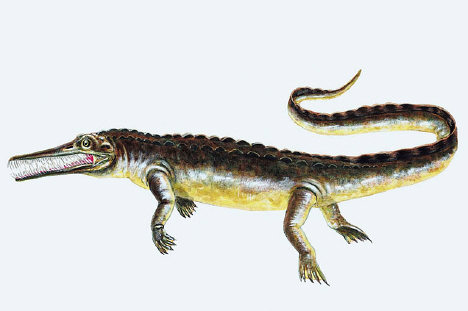[Recent Entries][Archive][Friends][User Info]
Below are the 2 most recent journal entries recorded in the "Сообщество, посвящённое ра" journal:| December 11th, 2011 | |
|---|---|
| 05:26 pm [industrialterro] [Link] |
Stereosternum Stereosternum is a genus of mesosaurid marine reptile from the Early Permian of Brazil. Named in 1886 by the famous paleontologist Edward Drinker Cope--who was presumably taking a break from chasing bigger dinosaurs--Stereosternum was a tiny marine reptile of the early Permian period that looked like a precisely scaled-down version of its better-known contemporary Mesosaurus. Judging by its delicate anatomy--especially its small, narrow head studded by fine, needle-like teeth--it's surmised that Stereosternum fed mostly on the small crustaceans inhabiting the lakes and rivers of South America. Stereosternum обнаружен только в Бразилии, отличался более слабым хвостом и, по современным реконструкциям, имел два окна в в черепе. Род Stereosternum, как считается, является наиболее примитивным в семействе и наименее приспособленным к жизни в воде.
Tags: Вымершие рептилии, Пермь, анапсиды, мезозавры |
| 04:49 pm [industrialterro] [Link] |
Mesosaurus Мезозавры (Mesosaurus) — вымерший род анапсидных рептилий раннего пермского периода из южной части Африки и Южной Америки. Мезозавр был длиной до 80 сантиметров, Ростр длинный, Зубы тонкие и острые, длина каждого переднего зуба более сантиметра, так что как мезозавр закрывал пасть - не совсем понятно,Хвост длинный и сжатый с боков, Питался рыбой. Мезозавры имеют важное значение в обеспечении доказательств теории континентального дрейфа, потому что его останки были найдены в южной части Африки и Восточной Южной Америке, двух достаточно отдаленных друг от друга местах. Так как мезозавры были пресноводными животными, и поэтому не могли пересекать Атлантический океан, это неопровержимо указывает на верность теории континентального дрейфа. Mesosaurus had a long skull that was larger than that of Stereosternum and had longer teeth. The teeth are angled outwards, especially those at the tips of the jaws. The bones of the postcranial skeleton are thick, having undergone pachyostosis. Mesosaurus is unusual among reptiles in that it possesses a cleithrum. A cleithrum is a type of dermal bone that overlies the scapula, and is usually found in more primitive bony fish and tetrapods. The head of the interclavicle of Mesosaurus is triangular, unlike those of other early reptiles, which are diamond-shaped. Mesosaurus was one of the first reptiles to return to the water after early tetrapods came to land in the Late Devonian or later in the Paleozoic. It was around 1 metre (3.3 ft) in length, with webbed feet, a streamlined body, and a long tail that may have supported a fin. It probably propelled itself through the water with its long hind legs and flexible tail. Its body was also flexible and could easily move sideways, but it had heavily thickened ribs, which would have prevented it from twisting its body. Mesosaurus had a small skull with long jaws. The nostrils were located at the top, allowing the creature to breathe with only the upper side of its head breaking the surface, in a similar manner to a modern crocodile. The teeth were originally thought to have been straining devices for the filter feeding of planktonic organisms. However, this idea was based on the assumption that the teeth of Mesosaurus were numerous and close together in the jaws. Newly examined remains of Mesosaurus show that it had fewer teeth, and that the dentition was suitable for catching small nektonic prey such as crustaceans. The pachyostosis seen in the bones of Mesosaurus may have enabled it to reach neutral buoyancy in the upper few meters of the water column. The additional weight may have stabilized the animal at the water's surface. Alternatively, it could have given Mesosaurus greater momentum when gliding underwater. While many features suggest a wholly aquatic lifestyle, Mesosaurus may have been able to move onto land for short periods of time. The elbows and ankles had restricted movement, making walking impossible. It is more likely that if Mesosaurus moved onto land, it would push itself forward in a similar way to living female sea turtles when nesting on beaches.
Ископаемые останки (1, 2, 3, 4, 5, 6, 7, 8):
( Далее ) Tags: Вымершие рептилии, Пермь, анапсиды, мезозавры |






/Meso_1.jpg)




